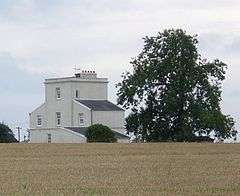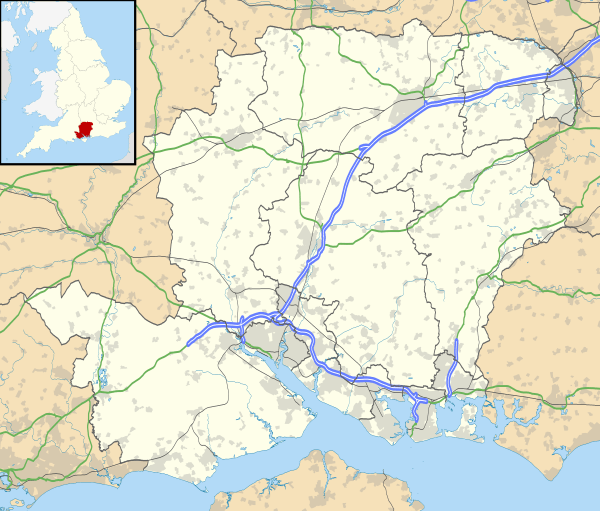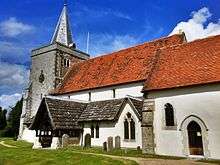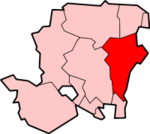Binsted
Binsted is a village and large civil parish in East Hampshire , England. It's about 4.1mi east of Alton, its nearest town. The parish is one of the largest in northern Hampshire and covers almost 7,000 acres (2,800 ha). It contains two villages, Bucks Horn Oak and Holt Pound, as well as two hamlets, Wyck and Wheatley. The parish also covers the entirety of the Alice Holt Forest, a royal forest situated near the border with Surrey. The nearest railway station is 1.8 miles (2.9 km) northeast of the village, at Bentley. According to the 2011 census, the parish had a population of 1,817 people.[1]
| Binsted | |
|---|---|
 Telegraph House, Binsted | |
 Binsted Location within Hampshire | |
| Population | 1,871 [1] |
| OS grid reference | SU771411 |
| Civil parish |
|
| District | |
| Shire county | |
| Region | |
| Country | England |
| Sovereign state | United Kingdom |
| Post town | ALTON |
| Postcode district | GU34 |
| Police | Hampshire |
| Fire | Hampshire |
| Ambulance | South Central |
| UK Parliament | |
The village was first mentioned as being part of the Hundred of Netham at the time of the Domesday Survey in 1086. The history of Binsted from the 11th to 19th centuries is not documented, owing to its isolation and non-involvement in controversial activity. The parish has 58 Grade II listed buildings, and one Grade I building – the Church of the Holy Cross.
History
At the time of the Domesday Survey, Binsted was listed as part of the Hundred of Netham as well as the Manor of Alton Westbrook. The village was referred to as "Benested", which means "holding of land".[2] Over the years there have been different variations on the spelling of the name, including Bensted, Benested and Boonsted (11th century), Bensted (14th century), and Bennsted (17th century).[2] The name most likely has its origin from the Saxon word "bin", meaning "heap".[lower-alpha 1] Before the Norman Conquest, the village was known as "Binsted Popham" and was held by Egbert of Wessex. The existing parish church was built in approximately 1140 AD.[2]
The history of Binsted from the 11th century to the early 19th century is not documented. A likely explanation is that the village remained a "simple agricultural community" and was not involved in any controversial activity, due to its isolation.[2] However, the Alice Holt Forest was an important supplier of timber from the 12th and 18th centuries, and the forest was claimed to have 13,000 trees "fit for ship building" in the early 17th century. Telegraph House, now a private home, was built by the Admiralty in 1825 as a semaphore relay station on the railway line linking London with Plymouth, with the intention to provide a number of key relay stations forming a line of communication between important points.[3][4] Binsted was recorded in the Imperial Gazetteer of England and Wales by John Marius Wilson in 1870.[lower-alpha 2] Five years later a school was built on land belonging to the Wickham Estate from stones brought from a pit near Semaphore House.[2]
Geography and demographics
Binsted is located in the eastern central part of Hampshire, South East England and is 4.1 miles (6.6 km) east of Alton, its nearest town.[6] The parish is one of the largest in North East Hampshire[7] and covers an area of around 7,000 acres (2,800 ha), extending from the edge of Alton to the Surrey border in the east. It also includes the entirety of the Alice Holt Forest.[8] The landscape is dominated by farms and woodland such as Binsted Farm, Wheatley Copse and Sparkfield Wood.[6] The parish contains two hamlets; Wyck and Wheatley, and two villages; Bucks Horn Oak and Holt Pound.[6] The River Wey forms the parish`s northern boundary.[8] According to the 2011 census, the parish of Binsted had a population of 1,817 people. In addition, there are 711 households in the parish with an average size of 2.56 people.[9]
Climate
Due to its location in south central England and its proximity to the sea, the average maximum temperature in January is 7.2 °C (45 °F) with the average minimum being 1.6 °C (35 °F). The average maximum temperature in July is 21.9 °C (71 °F), with the average minimum being 12.5 °C (55 °F). The hamlet gets around 755 millimetres (29.7 in) of rain a year, with a minimum of 1 mm (0.04 in) of rain reported on 103 days a year.[10]
| Climate data for Odiham weather station (nearest to Binsted), Odiham, elevation: 9 metres (30 feet) (1981–2010) | |||||||||||||
|---|---|---|---|---|---|---|---|---|---|---|---|---|---|
| Month | Jan | Feb | Mar | Apr | May | Jun | Jul | Aug | Sep | Oct | Nov | Dec | Year |
| Average high °C (°F) | 7.2 (45.0) |
7.4 (45.3) |
10.3 (50.5) |
13.0 (55.4) |
16.6 (61.9) |
19.5 (67.1) |
21.9 (71.4) |
21.6 (70.9) |
18.5 (65.3) |
14.4 (57.9) |
10.3 (50.5) |
7.4 (45.3) |
14.1 (57.4) |
| Average low °C (°F) | 1.6 (34.9) |
1.3 (34.3) |
3.0 (37.4) |
4.4 (39.9) |
7.5 (45.5) |
10.4 (50.7) |
12.5 (54.5) |
12.4 (54.3) |
10.2 (50.4) |
7.4 (45.3) |
4.2 (39.6) |
1.8 (35.2) |
6.4 (43.5) |
| Average precipitation mm (inches) | 77.8 (3.06) |
56.0 (2.20) |
54.8 (2.16) |
52.6 (2.07) |
52.2 (2.06) |
48.5 (1.91) |
50.2 (1.98) |
52.1 (2.05) |
61.8 (2.43) |
87.2 (3.43) |
83.9 (3.30) |
78.5 (3.09) |
755.5 (29.74) |
| Average precipitation days | 12.2 | 9.8 | 10.5 | 9.5 | 9.5 | 8.6 | 8.4 | 8.6 | 8.9 | 11.7 | 11.7 | 11.5 | 120.9 |
| Source: Met Office[10] | |||||||||||||
Notable landmarks

The parish contains a total of 58 Grade II listed buildings,[11] including a Grade II* listed barn,[12] and the Church of the Holy Cross, a Grade I listed building.[13] The church dates from the late 12th century with early 13th and 15th century additions, as well as a substantial restoration in 1863. The building itself consists of stone walls, a tiled roof, and a stone slated porch. The oldest part is the chancel, which dates from the 12th century with 15th century extensions. The north chapel was altered in 1331, and in its churchyard is the grave of famed Second World War Field Marshal Bernard Montgomery (Viscount Montgomery of Alamein).[13][14] Other listed buildings include Barnfield House – three houses which were once separated all dating from 1550 with 20th century restorations. The house itself has a timber frame with a tiled roof, including a late medieval hall.[15] Mill Court, another Grade II listed building, is a large house dating from the early 19th century with a low pitched roof and yellow brickwork, and became a listed building on 15 August 1985.[16]
References
Citations
- "Civil Parish population 2011". Neighbourhood Statistics. Office for National Statistics. Retrieved 9 December 2016.
- "The History of Binsted Village". Bentley Parish Council. Archived from the original on 7 July 2011. Retrieved 4 October 2016.
- "Telegraph House". Bentley Parish Council. Archived from the original on 24 July 2011. Retrieved 4 October 2016.
- "Binsted Village as it is today". Bentley Parish Council. Archived from the original on 7 July 2011. Retrieved 4 October 2016.
- "History of Binsted in East Hampshire". A Vision of Britain Through Time. University of Portsmouth. Retrieved 4 October 2016.
- Map of Binsted and surrounding area (Map). OpenStreetMap. Retrieved 26 January 2017.
- "Binsted Parish Council homepage". Binsted Parish Council. Retrieved 26 January 2017.
- "Binsted Civil Parish". Binsted Parish Council. 17 October 2014. Retrieved 26 January 2017.
- "Population of Binsted". Hampshire Hub. Archived from the original on 12 October 2016. Retrieved 4 October 2016.
- "Binsted 1981–2010 averages". Station, District and regional averages 1981–2010. Met Office. Retrieved 2 January 2017.
- "Listed Buildings in Binsted". British Listed Buildings. Retrieved 4 October 2016.
- "Barn 30 Metres North of West Court - Binsted". British Listed Buildings. Retrieved 4 October 2016.
- "Church of the Holy Cross - Binsted". British Listed Buildings. Retrieved 4 October 2016.
- "Grave Bernard Montgomery Binsted - Binsted - TracesOfWar.com". Traces of War. Retrieved 15 March 2017.
- "Barnfield House - Binsted". British Listed Buildings. Retrieved 4 October 2016.
- "Mill Court - Binsted". British Listed Buildings. Retrieved 4 October 2016.
Notes
- The Saxon word "Heap" most likely alluded to a "mound" marking a battle.[2]
- ... a parish and a subdistrict in the district of Alton, Hants. The parish lies 2½ miles SSW of Bentley r. station, and 4 NE by E of Alton; contains the hamlets of Issington, Week, Westcote, and Wheatley; and has a post office under Alton. Acres, 6,833. Real property, £7,104. Pop., 1,195. Houses, 231. Binstead Hill is the seat of the Coulthards. The living is a vicarage, united with the vicarage of Kingsley, in the diocese of Winchester. Value, not reported.* Patrons, the Dean and Chapter of Winchester. The church is ancient, has a low embattled tower and a spire, and contains several monuments. There is a Primitive Methodist chapel.-The subdistrict comprises eight parishes and an extra-parochial tract. Acres, 27,482. Pop., 4,806. Houses, 980.[5]
External links
| Wikimedia Commons has media related to Binsted, Hampshire. |
